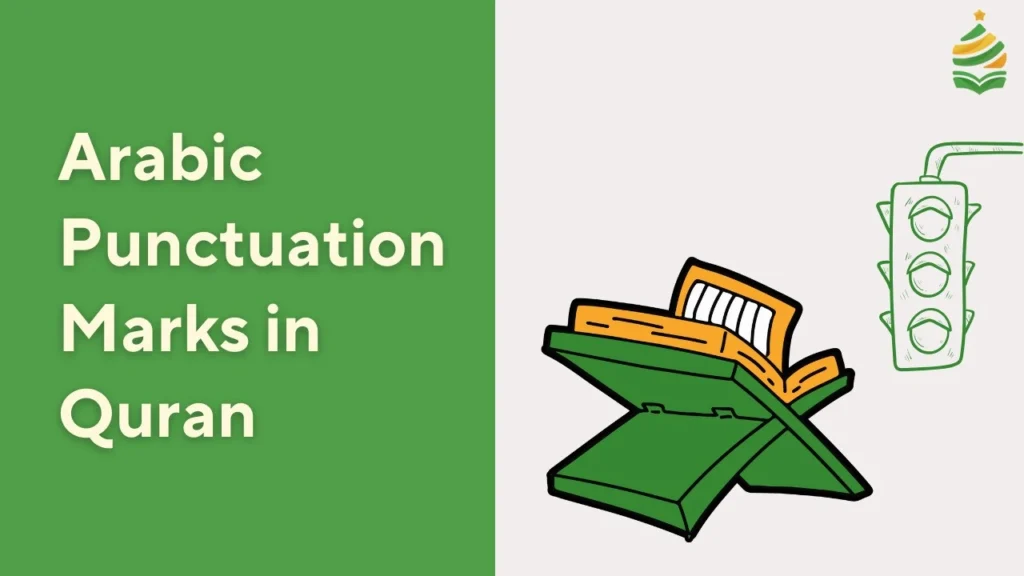Reciting the Quran isn’t the same as reading any other book because it was not revealed solely for reading but for contemplation and the practical application of its rulings in our daily lives. Thus, knowing the usage of Arabic punctuation marks in Quran is key to properly reciting the Quran, understanding its meanings, and pondering over them in a manner projected in our lives.
These punctuation marks include signs denoting that the reciter must pause in a certain position or isn’t allowed to pause in another all for the purpose of preserving the meaning of being changed. We’ll understand the Mandatory and Discretionary marks in detail and provide tips on how to practice them while reciting the Quran.
Why We Need Quranic Punctuation Marks?
The need for Quranic punctuation marks lies in helping individuals understand and interpret the Quran accurately.
These signs mark points where stopping is mandatory like م or where it is optional such as ج so that the reciter avoids misinterpreting the intended meaning of the verse. They ensure that all reciters of the Quran follow a standardized way of reciting the Quran that maintains its authenticity by following quran reading rules.
Arabic Punctuation Marks with Examples:
1. Full Stop
This sign marks the end of a verse and has an effect on the last letter of the verse. If this letter has Harakah (Fatha, Dhammah, Kasrah) or Tanween on it, it turns into Sukoon. On the other hand, if this letter has Tanween on the letter alif, it is changed into an elongated alif as in:
(الحمد لله الذي أنزل على عبده الكتاب ولم يجعل له عوجاً).
2. Stopping Signs in the Quran:
The marks addressed in this section are known as the stopping signs in Quran and we will tackle their two categories in detail; the signs of mandatory pause and the signs of discretionary pause.
1. Mandatory Pauses:
- م (m) – This is a sign of Waqf Lazim or mandatory pause. When you see this sign, you must stop your recitation at the required position so as not to cause a change in meaning.
Example: (لَعَنَهُ اللهۘ وَقَالَ لَأَتَّخِذَنَّ مِنْ عِبَادِكَ نَصِيبَاً مَفْرُوضَاً)
- ط (ṭ) – This symbol refers to Waqf Mutlaq or an absolute pause. It indicates that the reader better stop at this point in the verse.
Example: (يضلّ به كثيراً ويهدي به كثيراً ﯀ وما يضل به إلا الفاسقين)
- لا (la) – Using the word that means ‘no’ in Arabic, this is a sign of a Forbidden stop. Upon reaching this sign, you must continue your recitation without a pause because otherwise, you will completely change the meaning of the verse.
Example: (الّذَينَ يُنفِقُونَ أَمْوَالَهُمْ فِي سَبِيلِ اللهِ ثُمَّ لَا يُتْبِعُونَ مَا أَنفَقُوا مَنَّاً وَلَا أَذَىۙ لَهُمْ أَجْرُهُمْ عِندَ رَبِّهِمْ وَلَا َخَوْفٌ عَلَيْهِمْ وَلَا هُمْ يَحْزَنُون)
- س (s) It is short for Saktah or a short pause without taking a long breath. It takes place in certain verses of the Quran such as:
Example: (وقيل من ۜ راق)
- وقفة or وقف (wqf): This symbol is similar to the previous one but upon seeing it, the reader stops for a while longer than the Sakta. However, it is made without taking any breath and then the reader should resume their recitation.
Example: (ربنا ولا تحملنا ما لا طاقة لنا به واعف عناࣟۡ واغفر لناࣟ وارحمناࣟ أنت مولانا فانصرنا على القوم الكافرين)
2. Discretionary Pauses
- ج (j) – It takes from the first letter of the word جائز in Arabic, meaning permissible. This sign leaves it to the reciter’s discretion to either stop or continue the recitation without one being more preferrable than the other. An example of this pause is found in the Quran in verses like:
(أَوَلَمْ يَرَوا إِلَى الطَّيْرِ فَوْقَهُمْ صَافَّاتٍ وَيَقْبِضْنَۚ مَا يُمْسِكُهُنَّ إِلَّا الرَّحْمَن)
- (ز- ص-ق- ۖ ): These are symbols that the reciter has the choice to pause or continue but it is better to continue the recitation.
Example: (فأخرجهما مما كان فيهؐ)
- ◌ۗ: While continuing is allowed, stopping is better.
Example: (ما ننسخ من آية أو ننسها نأتِ بخير منها أو مثلها ۗ ألم تعلم أن الله على كل شيء قدير)
- ∴ (The embracing stop): This symbol is repeated twice in the verse to indicate that the reciter may stop at either points but cannot stop at both.
Example: (ذَٰلِكَ الْكِتَابُ لَا رَيْبَ ۛ فِيهِ ۛ هُدًى لِّلْمُتَّقِينَ)
Note: Join Almuhammadi Academy online quran recitation course to for proper understand of quran.
Additional Quran Punctuation Symbols
This section presents a group of marks that are found in editions of the Quran widespread in the Indian subcontinent and refer to certain pauses in the Quranic recitation:
- ه: This sign is to be seen at points where there is a difference of opinion among the scholars about the location of the pause.
- وقف النبي(Waqf an-Nabi): This sign refers to a point where the Prophet PBUH was reported to have paused while reciting.
- وقف منزل/ وقف جبريل(Waqf Munazzal/Waqf Jibril): Both of these terms indicates a pause that was made by Gabriel, the angel who was sent by Allah with the revelation of the Quran.
- وقف غفران(Waqf Ghufran): This sign corresponds with the interaction one must have with the recitation of the Quran because it signifies a pause that is considered to bring forgiveness upon the reciter.
- وقف كفران(Waqf Kufran): Originating from the Arabic word for disbelief, this is a mark where pausing is believed to be undesirable.
How to Practice Punctuation Marks in Quran:
At the beginning of their learning path, one may feel that learning the punctuation marks in the Quran is to be overwhelming and difficult but by following these tips, your path could become smoother:
1. Study their Meanings
The first crucial tip to achieve success in your quest to learn the Quranic punctuation marks is to have a clear understanding of each mark, its definition, and how to apply it while reciting the Quran. Such information provides the foundation for practice later on.
quranic punctuation marks, punctuation marks with examples, punctuation marks in quran, quran punctuation symbols
2. Follow a Tutor’s Direction
If things start getting a bit confusing, you may need the guidance and direction of a professional tutor that would clearly explain these marks of punctuation and rectify any mistakes pertaining to the application of them.
3. Stop and Reflect
As stated earlier, the Quran is recited for people to contemplate its glorious meanings and apply them to their lives so make use of the stopping signs in the Quran. Consider them as stops that guarantee a mindful reflection on the meanings of the Quran. This will allow you to form a deeper and stronger connection with the book of Allah.
Conclusion
This article has presented some insights into the meaning of the Arabic punctuation marks in the Quran along with examples. Still, of course, there is more to learn on this topic so make use of the available sources online to gain a deeper understanding of them and learn how to practice them as you to recite quran beautifully. Don’t hesitate to ask for the help of professional and expert Quran instructors to ensure greater success in your endeavor!


